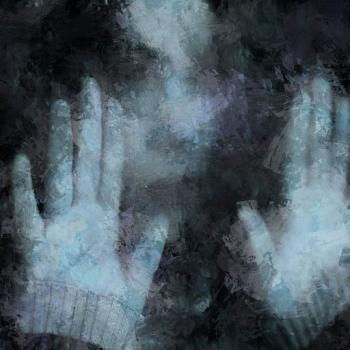Shadow Work.
Two words which describe a type of self-reflection which is both painful (some would say excruciating) and beneficial. I first heard of “Shadow Work” when studying Traditional Witchcraft with a mentor fourteen years ago. She described it as mental and emotional process integral to achieving spiritual balance. In my training, shadow work was an important precursor to spell-work because my mentor believed (and I’m paraphrasing here) – “how can you know your true intention if you do not know your Self?”
Important note: The above quote is one person’s view. Do not take it as gospel.

Carl Jung coined the term “shadow self” or “shadow aspect” as part of the psychological concept which describes human personality. The Shadow Self is the unconscious part which the Conscious Ego does not identify within itself. The Shadow Self is hidden and can be understood as the “dark side” which resides within each one of us. A concept which has been examined in literature such as Dr. Jekyll and Mr. Hyde.
According to those who’ve studied Jung, the shadow aspect or self includes everything which exists outside of the conscious self. Those things we reject about ourselves and can encompass both light and dark (IE: positive and negative) aspects. Character traits, behaviors, and attitudes within our personality which we may not even understand.
However, these “flaws” or this “dark side” are born of difficult (even traumatic) experiences or hurtful things people have said which we have accepted about ourselves. Things which are held deep within our subconscious self but escape in behavior, words, or difficult habits. The shadow self is also what allows a person to identify a disagreeable trait in other people, even as the same trait is dismissed or ignored within themselves.
Low self-esteem, anxiety, depression, fear, jealousy, sadness, anger management issues, addictive behaviors and being a gossip are all part of the shadow self. But here is the thing, even though what I’ve listed above is considered negative, difficult, or undesirable each of those traits are part of the human experience. They are natural and normal reactions to things a person deals with in life, albeit not always pleasant, healthy, or helpful.
However difficult the shadow is, it can also be the root of amazing creativity and powerful imagery. Edgar Allen Poe, who suffered from bouts of depression, fear of death and paranoia crafted masterpieces such as The Telltale Heart, The Raven, and The Cask of Amontillado (among other works) from within the depths of his shadow self. This does not mean the difficulties he endured were good, but he was able to take his pain and make something beautiful. The same could be said of Vincent Van Gogh, who even in his heartbreaking emotional and mental struggle created stunning pieces of art.

In February, my family and I recorded an episode about Shadow Work as part of our First Steps series for the 3 Pagans and a Cat podcast. A series which is intended to help those who are just starting out in Paganism or witchcraft and are looking for some general guideposts along their spiritual path. Ode and I believe it’s important to at least have an understanding of what shadow work is, and how a person might benefit from the practice, even if they are not in an emotional place to give the work a go.
Why is it important to acknowledge the “darkness” within yourself through shadow work?
As Carl Jung stated, “There is no light without shadow. No psychic wholeness without imperfection.” When we acknowledge and accept our shadow self (those things which have been bottled up or repressed, those parts of ourselves we or others have labeled as “dark”) we can heal or at least manage those emotions or negative impulses, express what affects us in a healthy manner, and hopefully achieve greater spiritual balance. This is helpful not only in our mundane lives but in our magickal practice as well.
Emotional and spiritual balance allows us to achieve a clear mind. We can know what we want to manifest in our lives without unconscious issues cropping up and muddying our efforts. Being more whole in an emotional/spiritual sense allows us to hone our intention and achieve greater focus.
Here is an important caveat.
Shadow work should not be rushed nor should it be done if a person does not have a good support system to help them deal with the emotions and/or issues shadow work could dig up. Do not undertake shadow work if you have a diagnosed or unaddressed mental health issue. A Jungian therapist or shadow work counselor would be good to consult first or to work with you in these instances.

Shadow work is not easy. If you do decide to proceed with shadow work at some point, be kind to yourself and don’t rush the process. Taking a deep look into our unconscious self is painful. So, if you are already dealing with depression or a stressful situation in your life then it’s better to wait until you are in a calm mind space. Also, if you have a strong framework or worldview of “evil” then you may want to wait or even skip shadow work.
Why?
Because if you have buried a part of yourself which falls into the “evil”, “sinful”, “wrong”, or “bad” category found in some religious frameworks and worldviews, then shadow work may dredge up things about yourself which are perfectly natural but could cause an emotional or spiritual crisis if you find such traits or behaviors to be “evil” or “wrong” and cannot accept or deal with these self-truths in an honest and healing manner.
At this point, you may be thinking I’m trying to scare you off the concept of shadow work altogether. Nothing could be further from the truth. Over the years, I have found shadow work to be very helpful in my life and my spiritual practice. But I do believe that anyone who undertakes examining their shadow self should do so with a complete understanding of the process and that it’s okay if you never want to go there. You will still be a whole human being. You will still be an effective Witch or Pagan without ever doing shadow work.
However, if you do want to plumb the depths of your inner self to discern what may be causing you to behave in a certain way or because you feel unsettled or stymied in your emotional or spiritual self then here are a couple of suggestions:
- Choose one aspect of your shadow to focus on at a time. Do not try to tackle all the issues you have recognized within yourself in one fell swoop. Shadow work will dredge up additional or related issues so make a note to deal with these things at a later date.
- Remember, this is not a one and done process. This is (or should be) a life-long, self-reflective practice to use as you change and grow over time. As human beings we are always moving forward (or should be) and shadow work can be a way to process and review difficult emotions, habits, or experiences throughout your adult life.
- Be honest with yourself. The point of shadow work is to recognize those things within your personality which you dislike or even hate. The goal at the end of shadow work is to be able to love yourself regardless of those difficult inner aspects, recognize how they came to be and do what is necessary to heal and move forward.

Basic Methods of Shadow Work
Journal – Choose one part of your shadow you want to acknowledge and work through. This can be a free-associated method. Ask yourself a series of questions “Why do I do…” and answer them honestly. Keep digging deeper with those questions, examine how you feel about it, until you get to the root of the issue. Take your time.
Meditation and Visualization – Use the same process as above but within a safe space in your mind/imagination. This can be done in state of trance or self-hypnosis if creative visualization is difficult for you. One possible suggestion is to talk to your “shadow” about these issues you wish to address.
Memory Regression – This is a method which should be done with a skilled hypnotist or licensed therapist who can help you remember a traumatic incident or period in your life and help you work through what happened and how to heal. Do not attempt shadow self memory regression alone.
Re-enactment/Performance – Act out (in a symbolic way) your bad behavior/habit, or what you do not like within yourself, to call up the emotions and then wrestle and deal with it in honest recognition. Ecstatic dance, drumming, or vocalizations (singing, shouting, etc.) can assist with this process by focusing on these “inner demons” and releasing them.














